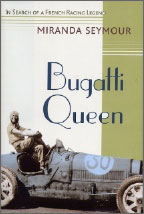 |
 Miranda Seymour
Miranda Seymour
Bugatti Queen
Reviewed by: Serena Trowbridge © 2005
Random House
US Hardback
ISBN: 1-4000-6168-7
Pages: 320; Price: $24.95
Date Reviewed: 5th February 2005
Index:
Non-Fiction
General Fiction
Recently I have been investigating the complex literary art of biography. Samuel Johnson said that
...the business of a biographer is often to pass slightly over those performances and incidents, which produce vulgar greatness, to lead the thoughts into domestick privacies, and display the minute details of daily life, where exterior appendages are cast aside, and men excel each other only by prudence and by virtue.
This is true, I have concluded, in many ways: it is often not the things for which the subject is famous that makes us enjoy a biography, but the personal, private things. However, modern biographies concentrate not so much on the "domestick privacies" which are indicative of prudence and virtue, but rather the salacious details of imprudence and vice. Bugatti Queen is certainly that kind of book, telling the story of Hellé Nice, a "fast" woman in every sense of the word.
Another interesting comment on biography comes from Siebenschuh in Fictional Techniques and Factual Works, where it is suggested that some biography is more "faction", i.e. fact + fiction - leading to possible genres such as the "non-fiction novel" and "biographical creation". Bugatti Queen is these things, too, and all the more enjoyable for it.
An experienced biographer, with previous subjects including Henry James and Mary Shelley, Seymour has written Bugatti Queen so that it reads like a novel, from the dramatic interpretive introduction examining her subject's life through contrasting photographs, to the smoothly-written (if slightly lurid) passages of life that follow. And what a subject she has here! She discovered the interesting life of Hellé Nice by chance, when a friend discovered one of Nice's scrapbooks which she had treasured in old age, and sent it to Seymour, who, using previously unseen documents, has revealed the life of a remarkable woman.
Nice was born Mariette Hélène Delangle, in an obscure French village in 1900, to working-class parents and with little indication of the illustrious and wild life she was to lead. However, Seymour introduces an appealing if somewhat sentimental pathos into the book from the start and with references throughout, by making it clear that this once celebrated woman died alone and in penury, remembering her glory days and desperately sad for the times that had passed. For her time she was a remarkable woman, taking the opportunity to do things that women had never done before. Little detail is known about her early life, so her story really begins when she moved to Paris in 1918, where she had some ballet training and earned a living working as a nude model. Eventually she became a celebrated dancer, compared with Karsavina, despite her tendency to take her clothes off. At this time she also became interested in the exciting, sleek cars which were to become her destiny, making friends with three young men who owned a car accessory business, although one of them, Henri de Courcelles, reputed to have been her first love, she was later to see die in a car crash at a race.
At 29 she suffered an injury which finished her dancing career, so she decided instead to concentrate on driving, working hard to learn all she could and quickly winning her first race. The thrill of the race is described well by Seymour, and even those (like myself) with little interest in cars cannot fail to be gripped by it. Her racing career forms the central focus of the book, especially as it takes off after Ettore Bugatti decided that she should drive his cars and promote them, being the most glamorous and famous female driver in France.
Her love of danger, of speed and thrills, clearly drove her throughout her career, but it also took her into perilous waters. The racing world was fraught not only with physical danger, in which many of Nice's friends were killed in crashes, but also with other temptations including drink, drugs, extravagance and sex. After a successful career during which the world seemed to be at Nice's feet, when she not only won races but was feted in many countries, appeared on advertisements, and counted wealthy and powerful men among her lovers, her downfall was rapid and surprising. Her racing career was waning by the start of the Second World War, yet she managed to live comfortably during the Occupation. The effects of the war on France are described in vivid detail, and certainly the effective consideration of the socio-historic context is one of the books strongest features. It is unknown what she was thought to have done, but she was accused of being a collaborator, and sank rapidly into obscurity from that point onwards, later deserted by her lover.
The contrasting images of the laughing girl in the Bugatti and the elderly woman alone with her scrapbooks and her memories create a lasting picture that is a fascinating tribute to a woman the 21st century had all but forgotten. Seymour tells her tale sympathetically, and the "faction" format works better here than I have seen in a long time.
|
 |
